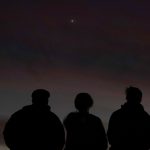BY MIKE LYNCH
Since summertime, the very bright planet Venus has held court in the Pottsville morning sky while Jupiter and Saturn have been headliners in the evening heavens. All good things come to an end though. All three planets are gradually going into hiding this month, but before they do they’re performing great final hurrahs!
In the early morning twilight, look for the extremely bright shiner Venus beaming away in the very low east-southeast sky, barely above the horizon. It rises above the horizon about an hour before sunrise. On Monday morning, let’s hope skies will clear enough because a very thin crescent moon will be parked just to Venus’s right. It should be quite a sight! Not only will you see the thin crescent but the rest of the moon’s disk will be bathed in a pale grayish light. The lovely dimmer light is called earthshine because that’s precisely what it is. The moon’s crescent is caused by direct sunlight, but the rest of the disk is being lit by sunshine bouncing off the Earth and onto the moon. Think of it as secondhand sunshine!
You’ll also see that Venus appears to be twinkling. That usually doesn’t happen. Generally speaking, you can tell stars from planets because stars twinkle and planets don’t. The pinpoint light from distant stars gets bounced around by our Earth’s atmosphere. Close to the horizon, planets can twinkle because the atmospheric layer is much thicker, causing the more substantial light from planets to bounce around as well.
As January progresses, Venus will be rising later and later while the sun will be rising earlier and earlier. By around Groundhog Day, Venus will be lost in the glow of our home star. Later this spring, we’ll begin to see Venus in the early evening. This is the last call for seeing Venus as the “morning star.”
Jupiter and Saturn are still hanging close together in the very early evening after the great show they put on in late December. This week, the moderately bright planet Mercury joins them but all three will be much tougher to see now because they pop out in the evening twilight very close to the horizon. You have to make sure you’re viewing them from a spot that allows you to see the horizon. A hilltop works best. At the start of the week, Jupiter, Saturn and Mercury will be grouped in a tight triangle. By around next Thursday and Friday, Mercury will shift to the upper left of the fading Jupiter and Saturn. At the same time, the new and very thin crescent moon will be joining the three planets. On Thursday evening, the moon will be perched just to the upper left of the planets. As an added attraction, you’ll once again enjoy the beautiful phenomena of earthshine bathing the moon.
As January marches on, Jupiter and Saturn will be setting earlier and the sun will be setting later as daylight increases. By late next week, they’ll completely disappear in the sun’s glow. Mercury, though, will still appear briefly in the low southwest evening sky.
Enjoy the early morning and early evening shows put on by the planets and the moon. All you need are your God-given eyes to see them. Unfortunately, because all of the planets are so close to the horizon they’ll all appear really fuzzy through any sized telescope. Again, that’s because of the thicker layer of Earth’s atmosphere. In fact, I would strongly advise you not to use a telescope because the sun is not all that far away from the planets in the sky. You never want to look at the sun through a telescope or binoculars. Even an accidental glimpse of the sun can cause permanent damage or even blindness.
Lynch, an amateur astronomer and professional broadcast meteorologist, can be reached at mikelynch@comcast.net.




